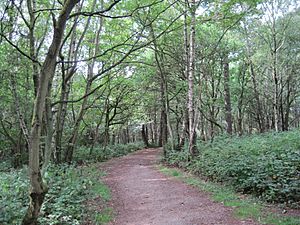Scratchwood facts for kids
Scratchwood is a large, mostly wooded park in Mill Hill, London. It's found in the London Borough of Barnet. This 57-hectare area is very important for nature. It's called a Site of Metropolitan Importance for Nature Conservation. Along with Moat Mount Open Space, it forms a special Local Nature Reserve.
Contents
What is Scratchwood?
Scratchwood is a piece of the old Middlesex Forest. It has the biggest area of very old woodland left in Barnet. Some parts of this forest might be as old as 11,500 years! That's when the last ice age ended.
Trees and Plants in Scratchwood
The oldest parts of the woodland have trees like sessile oak and hornbeam. You can also find some wild service trees here. Newer parts of the forest have birch, hawthorns, and sycamore trees. Experts from the London Ecology Unit say Scratchwood is the best woodland in the borough. It has many different kinds of plants, especially those that show it's an ancient forest. The grassy areas and the pond also have several rare plants.
Animals and Birds in Scratchwood
Many birds make Scratchwood their home. These include the nuthatch, lesser whitethroat, and cuckoo. It's a great place to spot different kinds of wildlife.
History of Scratchwood Land Use
The area south of the main entrance used to be hay meadows. Farmers grew hay there to feed London's many horses. In 1866, Scratchwood and Moat Mount became part of a big 400-hectare estate. A man named Edward William Cox bought it. He used Scratchwood for sports and raising game animals. Later, in 1923, the Hendon Urban District Council bought these areas. That's when they became nature reserves.
How to Visit Scratchwood
The main way to get into Scratchwood is through the car park. You can find it on the northbound side of Barnet Way. This road is part of the A1 road, near Stirling Corner. There's also a path from Barnet Lane in Elstree. The London Loop, a long walking trail, goes right through the reserve.
Mill Hill Golf Course: Nature and Sport
Mill Hill Golf Course is right next to Scratchwood, to the south. It's a 60-hectare area that's also important for nature. It's called a Site of Borough Importance for Nature Conservation, Grade I. About 150 years ago, this land was used for farming. Later, it became part of the same large estate that included Scratchwood and Moat Mount. The golf course itself was built in 1927.
Birdlife at Mill Hill Golf Course
This golf course is very special because of its many birds. You might even spot the rare willow tit here. It's a great place for birdwatching!
Water Features and Plants
Deans Brook starts on the golf course. Several small streams flow together to form Stoneyfields Lake. This lake was made by building a dam on the brook when the area was a country estate. The lake and streams are home to many plants that love water. Near Scratchwood, there's an area with acid grassland. Here, you can find unusual plants like dyer's greenweed and heath speedwell. There are also some bigger wooded areas, like Hemmings Wood at the southern end of the course.


